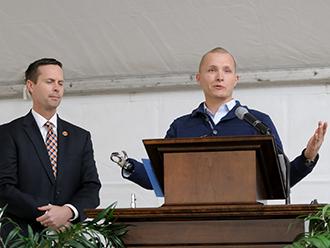Illinois University Preps Center to Cater to Wounded Veterans
The University of Illinois at Urbana-Champaign is building an unparalleled Center for Wounded Veterans with state-of-the-art assisted and adaptive devices. Wounded veterans can begin applying for early admission September 1.
Garrett Anderson already is a statistic. He is a wounded combat veteran. He is an amputee. He suffers from traumatic brain injury and post-traumatic stress disorder. But for his two daughters’ sake more than his own, Anderson says he’s working to avoid being counted in the daunting statistic that plagues 9.2 percent of U.S. veterans: unemployment.
Despite feeling overwhelmed, Anderson went back to school and attends the University of Illinois at Urbana-Champaign, where he is working toward a degree in social work.
“Often, we can accomplish more than we think, and in the face of adversity, we can push our limits more than ever,” says the former U.S. Army sergeant, wounded in October 2005 from a roadside bomb blast during a night patrol mission. Next year, he hopes to be among the selected wounded veteran-students to study at the newly constructed, state-of-the-art Chez Family Foundation Center for Wounded Veterans in Higher Education, which will cater to wounded veterans and their unique needs.
The $14 million facility will be a unique national center to give both residential and non-residential support to wounded veteran-students, making the University of Illinois at Urbana-Champaign the only institution of higher learning where the most severely wounded veterans will have residential accommodations on campus, says Tanya Gallagher, dean of the university’s College of Applied Health Sciences.
Veterans interested in attending can take advantage of the university’s priority filing period to enroll, which runs from September 1 to November 1.
Center staff and educators will place emphasis on education, employment, independence and reintegration into the community, areas that Defense Department officials and wounded veterans have indicated to university personnel as crucial, says Nick Osborne, the center’s interim director.
Programs will address the differences between veteran-students and the university’s population at large. Veteran-students tend to be older than their peers, often are married and have children, and “have a number of transition issues that they have to deal with,” Gallagher says. “Not only in terms of their disability, but in terms of rethinking a career when they may have been thinking about the military for their career.”
“Within that center, we will have residential facilities and comprehensive services, including academic services, counseling and family services for spouses and children as needed, and health and life skills services,” Gallagher continues. “There’s a great deal that our students need to learn” after suffering from a traumatic wound, from a whole new lifestyle to nutritional and fitness changes and even how to use the new state-of-the-art adaptive technologies.
In addressing the needs of wounded veterans, university staffers hope to make strides to assist individuals who might suffer from other forms of debilitating impairments, such as those suffered by the elderly or those injured in vehicle accidents, Gallagher says.
“Sometimes, the public image we have of severely wounded veterans is of dependence,” Gallagher remarks. “That is not what we see and is not really healthy. In the long run, there is a real productive future for them. Their mean age is 35. You can’t simply say that their satisfaction from contribution is now reduced and limited.”
Read more about the advanced assisted technology and adaptive devices available to wounded student-veterans in “Higher Education for Wounded Warriors Exploit New Technologies” in the upcoming September edition of SIGNAL Magazine.





Comments